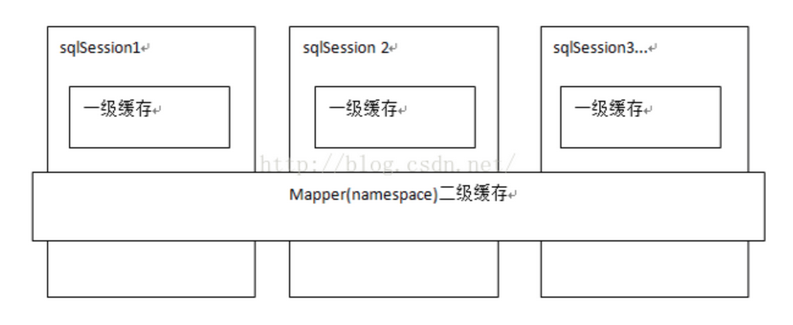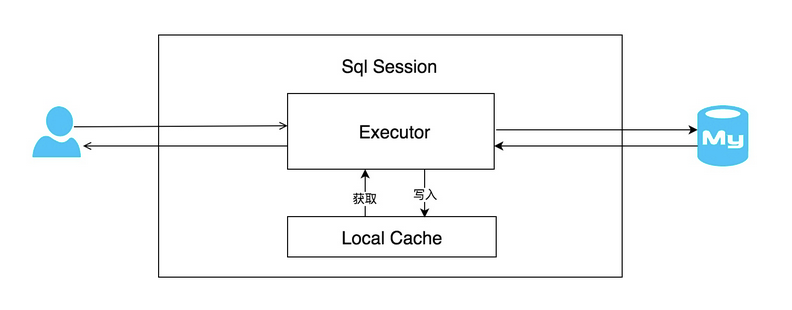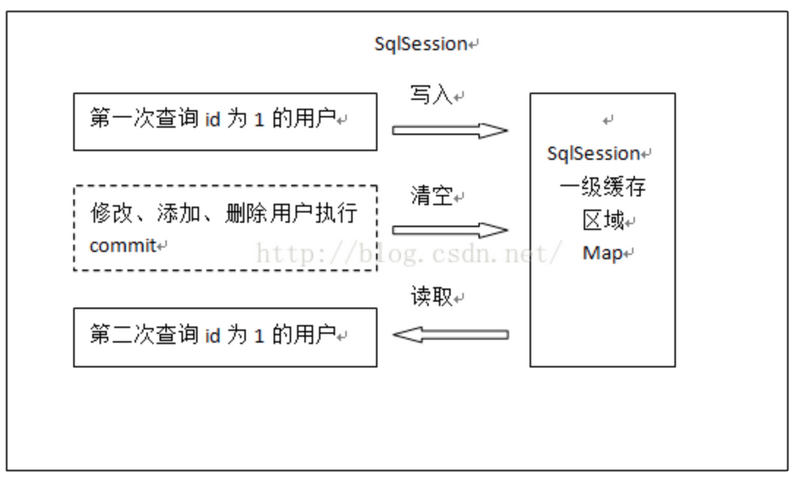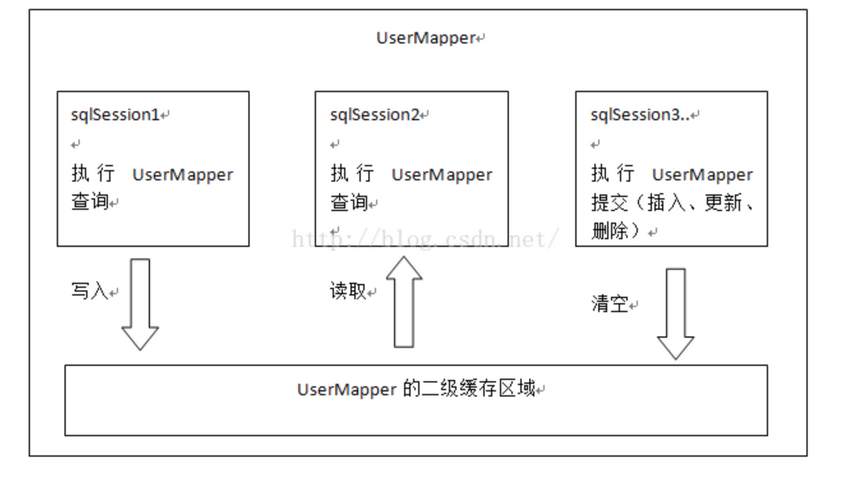Mybatis的缓存机制
mybatis的代理详解
Java中动态代理主要是JDK动态代理(接口),CGLib动态代理(类继承)
SqlSession sqlSession = sqlSessionFactory.openSession();
/** *在通过sqlSession.getMapper可以获取一个代理对象 * 对于StudentMapper并没有显性的实现该接口的实现类, * 该对象是在运行时动态产生的,该对象就是动态代理对象 * * JDK动态代理 * 1、首先存在接口(StudentMapper.java) * 2、必须存在该接口的实现类(sqlSession.selectOne) * 3、实现invocationHandler辅助类 * 4、通过Proxy类来产生代理对象 */
//单个对象原始调用方式
// Student student = sqlSession.selectOne("com.tulun.Mybatis.mapper.StudentMapper.selectStudentById", 4);
StudentMapper studentMapper = sqlSession.getMapper(StudentMapper.class);
Student student = studentMapper.selectStudentById(4);
System.out.println(student);
mybatis是否用到了JDK动态代理相关的接口和类?产生代理对象如何组织?
mybatis中代理对象的获取是通过如下方法:
sqlSession.getMapper(StudentMapper.class);
mapper接口是如何添加进去的?
通过Java代码形式来进行数据源、映射文件的配置形式如下:
Configuration configuration = new Configuration();
PooledDataSourceFactory dataSourceFactory = new PooledDataSourceFactory();
DataSource dataSource = dataSourceFactory.getDataSource();
JdbcTransactionFactory jdbcTransactionFactory = new JdbcTransactionFactory();
//设置环境
Environment environment = new Environment("test", jdbcTransactionFactory, dataSource);
configuration.setEnvironment(environment);
//设置mapper接口
configuration.addMapper(StudentMapper.class);
new SqlSessionFactoryBuilder().build(configuration);
重点在于接口的添加形式:
configuration.addMapper(StudentMapper.class);
在Configuration类中:
public <T> void addMapper(Class<T> type) {
mapperRegistry.addMapper(type);
}
mapper在Configuration类中没有做任何事,只是添加到mapperRegistry类中。
public <T> void addMapper(Class<T> type) {
if (type.isInterface()) {
//只允许添加接口
if (hasMapper(type)) {
//不允许重复添加
throw new BindingException("Type " + type + " is already known to the MapperRegistry.");
}
boolean loadCompleted = false;
try {
knownMappers.put(type, new MapperProxyFactory<T>(type));
MapperAnnotationBuilder parser = new MapperAnnotationBuilder(config, type);
parser.parse();
loadCompleted = true;
} finally {
if (!loadCompleted) {
knownMappers.remove(type);
}
}
}
执行的configuration.addMapper(StudentMapper.class),实际上最终被放入HashMap中,其命名knownMappers,它是mapperRegistry类中的私有属性,是一个HashMap对象,key是接口class对象,value是MapperProxyFactory的对象实例。
通过getMapper获取代理对象。
DefaultSqlSession类:
public <T> T getMapper(Class<T> type) {
return configuration.<T>getMapper(type, this);
}
configuration类中存放所有的mybatis全局配置信息,从参数上可以知道class类型。
configuration类:
public <T> T getMapper(Class<T> type, SqlSession sqlSession) {
return mapperRegistry.getMapper(type, sqlSession);
}
configuration类中getmapper调用了mapperRegistry.getMapper,mapperRegistry中存放一个HashMap
。
mapperRegistry类:
private final Map<Class<?>, MapperProxyFactory<?>> knownMappers = new HashMap<Class<?>, MapperProxyFactory<?>>();
public <T> T getMapper(Class<T> type, SqlSession sqlSession) {
final MapperProxyFactory<T> mapperProxyFactory = (MapperProxyFactory<T>) knownMappers.get(type);
if (mapperProxyFactory == null) {
throw new BindingException("Type " + type + " is not known to the MapperRegistry.");
}
try {
return mapperProxyFactory.newInstance(sqlSession);
} catch (Exception e) {
throw new BindingException("Error getting mapper instance. Cause: " + e, e);
}
}
调用mapperRegistry类中的getMapper方法,该方法中会到hashmap中通过类名获取对应的value值,是MapperProxyFactory对象,然后调用newInstance方法,该方法是创建了一个对象。
public class MapperProxyFactory<T> {
//映射器代理工厂
private final Class<T> mapperInterface;
private final Map<Method, MapperMethod> methodCache = new ConcurrentHashMap<Method, MapperMethod>();
@SuppressWarnings("unchecked")
protected T newInstance(MapperProxy<T> mapperProxy) {
//使用的是JDK自带的动态代理对象生成代理类对象
return (T) Proxy.newProxyInstance(mapperInterface.getClassLoader(), new Class[] {
mapperInterface }, mapperProxy);
}
public T newInstance(SqlSession sqlSession) {
final MapperProxy<T> mapperProxy = new MapperProxy<T>(sqlSession, mapperInterface, methodCache);
return newInstance(mapperProxy);
}
}
public class MapperProxy<T> implements InvocationHandler, Serializable {
//实现了InvocationHandler接口
@Override
//代理之后,所有的mapper的方法调用,都会调用这个invoke方法
public Object invoke(Object proxy, Method method, Object[] args) throws Throwable {
if (Object.class.equals(method.getDeclaringClass())) {
try {
return method.invoke(this, args); //该位置就调用了原始的调用方法:SQLSession.selectOne
} catch (Throwable t) {
throw ExceptionUtil.unwrapThrowable(t);
}
}
final MapperMethod mapperMethod = cachedMapperMethod(method);
//执行CURD操作
return mapperMethod.execute(sqlSession, args);
}
}
mybatis中getmapper的代理对象的获取,使用的是JDK动态代理,在MapperRegistry类中的HashMap中存放了所有的mapper接口,key是接口的类名信息,value是MapperProxyFactory类型实例,getmapper操作会是当前对象调用newInstance操作,该操作会调用Proxy.newProxyInstance核心在于调用InvocationHandler接口,实现了invoke方法,除了调用原始的接口调用,而且还对调用进行增强,进行了方法缓存,且最终会执行增删改查操作。
总结Mapper接口方法执行的几个点:
- Mapper接口初始在SQLSessionFactory注册的。
- Mapper接口注册在MapperRegistry类的HashMap中,key是mapper的接口类名,value是创建当前代理工厂。
- Mapper注册之后,可以从过SQLSession来获取get对象。
- SQLSession.getMapper运用了JDK动态代理,产生了目标Mapper接口的代理对象,动态代理的代理类是MapperProxy,实现了增删改查调用。
mybatis的缓存机制
缓存介绍
mybatis中提供查询缓存,用于减轻数据库的压力,提高数据库的性能。
mybatis提了了一级缓存和二级缓存:
一级缓存是SQLSession级别缓存,在操作数据库时都需要构造SQLSession对象,在对象中有一个数据结构(HashMap)用于存储缓存数据,不同的SQLSession之间的缓存数据区域是互不影响的。
一级缓存的作用于是在同一个SQLSession,在同一个SQLSession中执行相同的两次SQL,第一次执行完毕在后会将数据写到缓存中,第二次从缓存中进行后去就不在数据库中查询,从而提高了效率,
当一个SQLSession结束后该SQLSession中的一级缓存也就不存在了,mybatis默认开启一级缓存。
二级缓存是mapper级别缓存,多个SQLSession去操作同一个mapper的SQL语句,多个SQLSession操作都会存在二级缓存中,多个SQLSession共用二级缓存,二级缓存是跨SQLSession的。
二级缓存是多个SQLSession共享的,作用域是mapper下的同一个namespace。不同的SQLSession两次执行相同的namespace下的SQL最终能获取相同的SQL语句结果。
mybatis默认是没有开启二级缓存的,需要在全局配置文件中配置开启二级缓存。
一级缓存
一级缓存介绍
每个SqlSession中持有一个执行器Executor,每个执行器中有一个Local Cache,当用户发起查询时,mybatis根据当前执行的语句生成mapperStatement,在Local Cache中进行查询,如果缓存命中的话,直接返回给用户,如果没有命中,查询数据库,结果写入Local Cache中,最后返回给用户。
通过ID查询用户信息:
缓存生效失效时机:
如果是连续的查询同一个数据操作,在第一次查询之后,后续查询都可以命中缓存。
如果在查询之后,紧接着是进行变更操作,就会导致缓存失效。
一级缓存测试
mybatis是默认支持一级缓存,不需要做其他配置。
测试1:同一个SQLSession下连续进行查询操作:
//同一个SQLSession连续进行查询操作
StudentMapper studentMapper = sqlSession.getMapper(StudentMapper.class);
//第一次查询操作
System.out.println("第一次查询开始......");
Student student = studentMapper.selectStudentById(4);
System.out.println("第一次查询结束......");
System.out.println("第二次查询开始......");
Student student1 = studentMapper.selectStudentById(4);
System.out.println("第二次查询结束......");
通过执行结果可知:第一次查询会查询数据库,第二次查询操作是没有查询SQL,即通过缓存查询到结果返回。
测试2:第一次查询结束后,对数据进行变更操作,再次执行查询操作:
//同一个SQLSession连续进行查询操作
StudentMapper studentMapper = sqlSession.getMapper(StudentMapper.class);
//第一次查询操作
System.out.println("第一次查询开始......");
Student student = studentMapper.selectStudentById(4);
System.out.println("第一次查询结束......");
//对数据进行变更操作
System.out.println("变更操作开始....");
studentMapper.updateNameById(4,"test");
sqlSession.commit();
System.out.println("变更操作结束....");
//第二次查询
System.out.println("第二次查询开始......");
Student student1 = studentMapper.selectStudentById(4);
System.out.println("第二次查询结束......");
在查询结束后,如果对于数据进行变更操作,会删除掉缓存,导致第二次查询依然需要进入到数据库。
case3:不同的SQLSession下同一个操作是否会命中缓存:
SqlSession sqlSession = sqlSessionFactory.openSession();
//分别数据不同的SQLSession是否会命中缓存
StudentMapper studentMapper = sqlSession.getMapper(StudentMapper.class);
//第一次查询操作
System.out.println("第一次查询开始......");
Student student = studentMapper.selectStudentById(4);
System.out.println("第一次查询结束......");
SqlSession sqlSession1 = sqlSessionFactory.openSession();
StudentMapper studentMapper1 = sqlSession1.getMapper(StudentMapper.class);
//第二次查询
System.out.println("第二次查询开始......");
Student student1 = studentMapper1.selectStudentById(4);
System.out.println("第二次查询结束......");
不同的SQLSession的一级缓存是无法共享的。
二级缓存
mybatis中二级缓存是mapper级别的缓存,默认是关闭的。
对于一个mapper下的不同的SQLSession可以共享二级缓存。
不同的mapper是相互隔离的。
二级缓存的特点是需要打开二级缓存的配置,并且需要映射的java类需要实现序列化。
二级缓存原理
二级缓存和一级缓存的区别:
二级缓存范围更大,多个SQLSession可以共享一个mapper级别的二级缓存,数据类型依然是HashMap来存储二级缓存内容,mapper是按照namespace划分,如果namespace相同则使用同一个二级缓存,
一级缓存范围会更小,是一个SQLSession级别。
二级缓存使用步骤
第一步:在mybatis的全局配置文件中开启二级缓存:
<settings>
<!--cacheEnabled:开启mybatis的二级缓存-->
<setting name="cacheEnabled" value=" true"/>
</settings>
第二步:将映射的pojo类实现序列化:
public class Student implements Serializable
第三步:在mapper配置文件中使用cache标签:
<!--
cache和二级缓存相关标签
eviction属性:代表缓存的回收策略,mybatis提供了回收策略如下:
LRU:最近最少使用,对于最长时间不用的对象进行回收
FIFO:先进先出,按照帝乡进入缓存的顺序来进行回收
SOFT:软引用,移除基于垃圾回收器状态和软引用规则的对象
WEAK:弱引用,基于垃圾回收器状态和弱引用规则的对象
flushInterval属性:刷新间隔时间,单位是毫秒
size属性:引用数目,代表缓存可以存储最多多少个对象
readOnly属性:只读,意味着缓存数据只能读取不能修改
-->
<cache eviction="FIFO" flushInterval="1000" size="1024" readOnly="false"/>
注:在select查询导致上使用属性:
useCache=“true” 缓存的使用和禁止
flushCache=“true” 刷新缓存
二级缓存使用测试
//二级缓存的测试
@Test
public void testCache2() {
//不同的SQLSession会话进行相同的SQL查询操作
//SQLSession1实例
SqlSession sqlSession = sessionFactory.openSession();
Student23Mapper student23Mapper = sqlSession.getMapper(Student23Mapper.class);
//SQLSession2实例
SqlSession sqlSession1 = sessionFactory.openSession();
Student23Mapper student23Mapper1 = sqlSession1.getMapper(Student23Mapper.class);
//sqlsession实例3
SqlSession sqlSession2 = sessionFactory.openSession();
Student23Mapper student23Mapper2 = sqlSession2.getMapper(Student23Mapper.class);
//第一次查询id为1的用户
Student23 student23 = student23Mapper.selectStudentByUid(1L);
System.out.println(student23);
//这里执行关闭操作,将SQLSession中的数据写入到二级缓存区域
sqlSession.close();
//第二次查询id为1的用户
Student23 student24 = student23Mapper1.selectStudentByUid(1L);
System.out.println(student24);
sqlSession1.close();
}
表明不同的SQLSession可以共享一个二级缓存。
底层:二级缓存是一个Cache接口的实现类,一级缓存是一个localCache是一个HashMap的属性,
执行过程先经过二级缓存,在二级缓存未命中时才会走一级缓存。
今天的文章Mybatis的缓存机制分享到此就结束了,感谢您的阅读。
版权声明:本文内容由互联网用户自发贡献,该文观点仅代表作者本人。本站仅提供信息存储空间服务,不拥有所有权,不承担相关法律责任。如发现本站有涉嫌侵权/违法违规的内容, 请发送邮件至 举报,一经查实,本站将立刻删除。
如需转载请保留出处:https://bianchenghao.cn/9222.html





